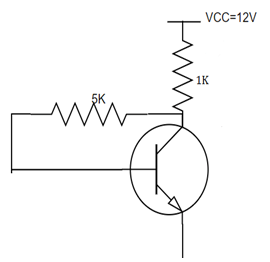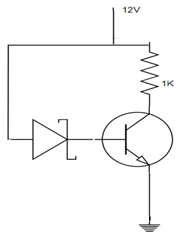This set of Electronic Devices and Circuits Multiple Choice Questions & Answers (MCQs) focuses on “Collector-to-Base Bias”.
1. The collector current (IC) that is obtained in a collector to base biased transistor is_________
a) (VCC-VBE)/RB
b) (VCC+VBE)/RB
c) (VCE-VBE)/RB
d) (VCE+VBE)/RB
View Answer
Explanation: The collector current is analysed by the DC analysis of a transistor. It involves the DC equivalent circuit of a transistor. The base current is first found and the collector current is obtained from the relation, IC=IBβ.
2. The collector to emitter voltage (VCE) is obtained by_________
a) VCC – RC(IC-IB)
b) VCC – RC(IC+IB)
c) VCC + RC(IC+IB)
d) VCC + RC(IC-IB)
View Answer
Explanation: The collector to emitter voltage is obtained in order to find the operating point of a transistor. It is taken when there is no signal applied to the transistor. The point thus obtained lies in the cut off region when the transistor is used as a switch.
3. What is the DC characteristic used to prove that the transistor is indeed biased in saturation mode?
a) IC = βIB
b) IC > βIB
c) IC >> βIB
d) IC < βIB
View Answer
Explanation: When in a transistor is driven into saturation, we use VCE(SAT) as another linear parameter. In, addition when a transistor is biased in saturation mode, we have IC < βIB. This characteristic used to prove that the transistor is indeed biased in saturation mode.
4. The thermal runway is avoided in a collector to base bias because_________
a) of its independence of β
b) of the positive feedback produced by the base resistor
c) of the negative feedback produced by the base resistor
d) of its dependence of β
View Answer
Explanation: The self destruction of a transistor due to increase temperature is called thermal run away. It is avoided by the negative feedback produced by the base resistor in a collector to base bias. The IC which is responsible for the damage is reduced by decreased output signal.
5. When the temperature is increased, what happens to the collector current after a feedback is given?
a) it remains same
b) it increases
c) it cannot be predicted
d) it decreases
View Answer
Explanation: Before the feedback is applied, when the temperature is increased, the reverse saturation increases. The collector current also increases. When the feedback is applied, the base current increases with decreasing collector current and the thermal runway too.
6. The demerit of a collector to base bias is_________
a) its need of high resistance values
b) its dependence on β
c) its independence on β
d) the positive feedback produced by the base resistor
View Answer
Explanation: When the stability factor S=1, the collector resistor value should be very large when compared to the base resistor. So, when RC is large we need to provide large power supply which increases the cost. At the same time, as the base resistor is small we need to provide small power supply.
7. The negative feedback does good for DC signal by_________
a) decreasing the gain
b) increasing the gain
c) stabilising the operating point
d) increasing the stability factor
View Answer
Explanation: The resistor RB can provide negative feedback for both AC and DC signals. The negative feedback for DC signal is done good as it can provide stable operating point. On the other side, the negative feedback is badly done for AC signal by decreasing the voltage gain.
8. In the circuit, transistor has β =60, VBE=0.7V. Find the collector to emitter voltage drop VCE.

a) 5V
b) 3V
c) 8V
d) 6V
View Answer
Explanation: We know, IC=(VCC-VBE)/RB
By putting the values, we have IC=5.9mA. IE=IC/α. So, IE=5.99mA.
VCE= VCC-RC(IC+IB). We have VCE=6V.
9. In the circuit shown below, β =100 and VBE=0.7V. The Zener diode has a breakdown voltage of 6V. Find the operating point.

a) (6.7V, 5.3mA)
b) (5.7V, 5.3mA)
c) (6.7V, 5mA)
d) (6V, 5mA)
View Answer
Explanation: We know, by KVL -12+(IC+IB)1K+6+VBE=0
We have IE=5.3. IC= αIE=5.24mA. From another loop, -12+IEIK+VBE=0
We have, VCE=12-5.3m*1000=6.7V. Hence the Q point is (6.7V, 5.3mA).
10. When the β value is large for a given transistor, the IC and VCE values are given by_________
a) (VCC-VBE)/RB, VCC-RCIC
b) (VCC+VBE)/RB, VCC-RC(IC+IB)
c) (VCC+VBE)/RB, VCC+RC(IC+IB)
d) (VCC+VBE)/RB, VCC+RC(IC-IB)
View Answer
Explanation: The base current IB is zero when β value is large. So, the VCE changes to VCC-RCIC. The collector current IC is changed to (VCC-VBE)/RB from β(VCC-VBE)/(1+ β)RE+ RB.
Sanfoundry Global Education & Learning Series – Electronic Devices and Circuits.
To practice all areas of Electronic Devices and Circuits, here is complete set of 1000+ Multiple Choice Questions and Answers.
If you find a mistake in question / option / answer, kindly take a screenshot and email to [email protected]
